
Subconjunctival Hemorrhage
The conjunctiva is the clear, very thin, moist membrane that covers the white part of the eye (the sclera). The conjunctiva has many fine delicate blood vessels that run through it. Usually these blood vessels are constricted and small, and barely visible.
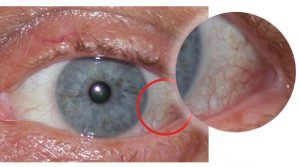
Normal conjunctiva
When an eye becomes inflamed, such as in cases of conjunctivitis (“pink eye”), the conjunctival blood vessels are enlarged and dilated, and become much more visible.
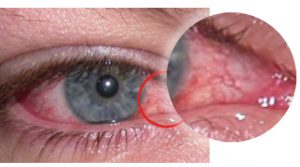
Dilated conjunctival vessels in pink eye
A subconjunctival hemorrhage (sometimes referred to as a “conjunctival hemorrhage” or “eye bleed”) occurs when one of the conjunctival blood vessels ruptures and leaks out blood. The blood then becomes trapped between the clear conjunctiva and the underlying white sclera.
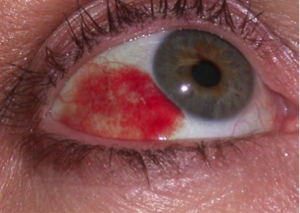
subconjunctival hemorrhage
The blood may then initially spread along the sclera (and appear larger) over the first 24 hours before it slowly absorbs away over the next few weeks.
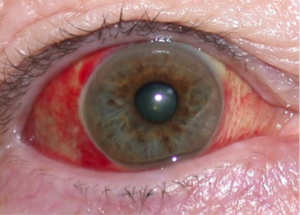
Blood spreading along the sclera
What causes a subconjunctival hemorrhage?
A subconjunctival hemorrhage may occur as a result of an injury/trauma, from a bout of sneezing, coughing, or vomiting (anything that makes you strain), or may occur spontaneously. Often, people will wake up with the hemorrhage and only notice it when they look in the mirror or someone mentions it to them.
A subconjunctival hemorrhage is essentially a “bruise” on the white part of the eye. A bruise on the skin occurs when blood vessels are injured and leak blood underneath the skin. The blood absorbs into the tissues, and through the overlying skin the bruise appears dark blue or purple. On the eye, unlike the skin, the conjunctiva is clear, so the blood appears brighter red.
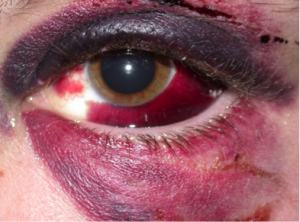
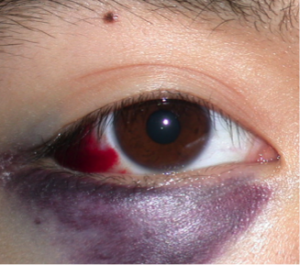
Eyelid bruising and subconjunctival hemorrhages
What are the symptoms of a subconjunctival hemorrhage?
Other than the appearance of redness, usually a subconjunctival hemorrhage is painless. Often, people are aware of something different about the eye or slight irritation if the blood is elevated, but once the blood flattens out the eye generally feels completely normal.
Is a subconjunctival hemorrhage dangerous or a threat to my vision?
No. A subconjunctival hemorrhage is almost always a benign incident and will not affect your vision.
Is a subconjunctival hemorrhage a sign of high blood pressure?
People with a history of high blood pressure may be more prone to develop subconjunctival hemorrhages.
Is a subconjunctival hemorrhage related to my blood thinners?
It can be. Just like anticoagulant medications (blood thinners) such as aspirin may make you more prone to bleeding and bruising, they may make you more prone to subconjunctival hemorrhages. But there is no need to discontinue your blood thinners solely because of a subconjunctival hemorrhage.
Is there treatment for a subconjunctival hemorrhage?
Typically the blood will resorb on its own over a few weeks. There is no treatment that will make the blood go away any faster. Eye drop products that “get the red out” are designed to constrict dilated blood vessels for “bloodshot eyes.” They do not do anything for the blood/redness from a subconjunctival hemorrhage. You can use artificial tear drops for any irritation associated with the subconjunctival hemorrhage.
Recent Comments